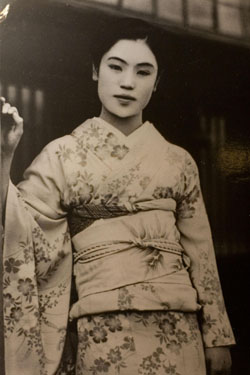Since there was such an interest in the truth of the fascinating onna-bugeisha, I thought I would talk a bit about another group of japanese women I've spent some time studying - the geisha.
Secrecy is the byword of the karyūkai (flower and willow world) that the geisha inhabit. Part of their allure is their mystery. What thoughts lie behind those carefully painted smiles?
To begin to understand something of the little we know about the geisha, first we have to understand their history. I referred a moment ago to the flower and willow world. That isn't merely a pretty name for the highly ritual, matriarchal microcosm of society that the geisha inhabit. It's a descriptor: in the old days, courtesans and prostitutes (of varying degrees of social status) were the colorful flowers, while the skilled, dignified geisha were the willows.
While geisha themselves didn't sell sex for money (sort of... sometimes... it's complicated), they descended from an elite rank of courtesans known as oiran. During the Edo period (1600 - 1868) laws were passed that restricted prostitutes to selling their wares in walled districts called yukaku set away from city centers. These yukaku quickly became pleasure quarters popular with wealthy men, and two ranks of prostitutes formed: the second-class tayu, and the elite oiran who were not only beautiful, but quick-witted and skilled in the arts besides.
Restricted inside these pleasure quarters, the oiran quickly fell out of touch with modern society and actually grew too refined to sell their wares. The ancient arts of tea ceremony, flower arranging, and calligraphy were nice, but they didn't entertain a man. It was time for something new.
Enter the geisha.
Today we think of geisha as beautiful relics of the past. But in their time they were fashion plates trained in singing and dancing... not so different from idealized women of our own time, like Beyonce. They weren't some fond remembrance, they were firmly steeped in the current culture and fashion forward. Housewives modeled their own clothes off the daring styles of the geisha.
In the beginning, geisha were actually forbidden to sell sex in order to protect the rights of the licensed courtesans (prostitution wasn't made illegal in Japan until 1956). So instead, geisha focused on ways to entertain men as equals. While mainstream japanese society dictated that women be meek and obedient, geisha were allowed to be fun. And geisha society was the one place where women were allowed to own and run businesses. In the teahouses where geisha sold their dancing and laughter, women dominated.
This, between the late 1700s and early 1900s, was the heyday of the geisha.



No comments:
Post a Comment